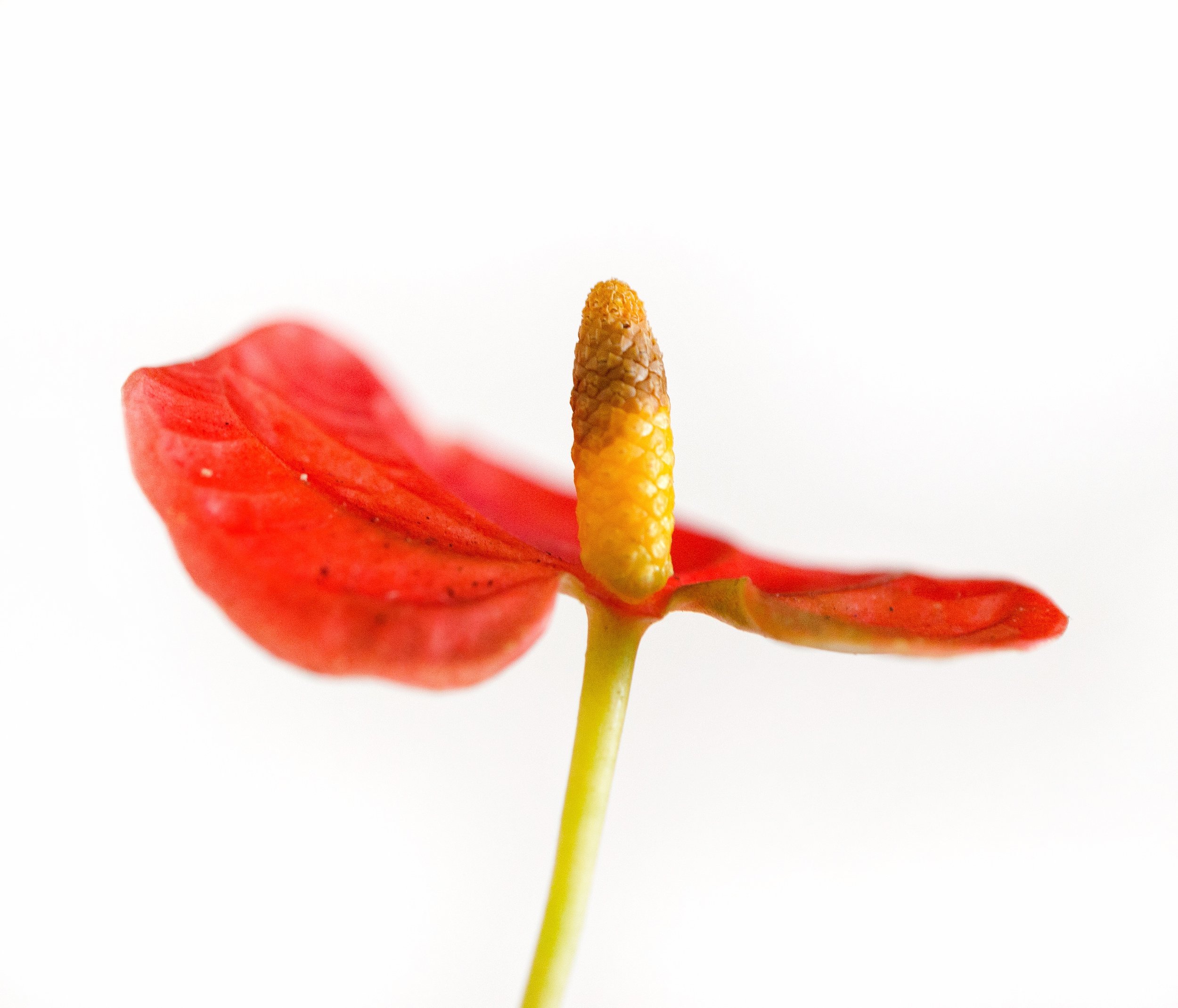Plant profiles: Anthurium andraeanum (flamingo flower)
Anthurium andraeanum (also called flamingo flower or lace leaf) is one of the most striking and recognizable houseplants available, and for good reason! Glossy spade-like leaves encompass lustrous, vivid flowers that are sometimes mistaken for plastic. The iconic "flowers" are often cut and used in floral arrangements, and come in a range of colors depending on variety or hybrid of Anthurium. The “flowers” are actually called inflorescences and contain two parts: the spathe and the spadix. This type of inflorescence is a hallmark of the family Araceae that Anthurium adraeanum belongs to. You'll see similar inflorescences on related plants such as peace lilies (Spathiphyllum wallisii) and calla lilies (Zantedeschia aethiopica)! The spike-shaped spadix (which is often yellow, but sometimes red or pink) has a surface packed tightly with tiny flowers. The spadix is encased within the colorful spathe, which is actually a bract or modified leaf and not a petal like many people think!
There are several species of Anthuriums, which all bear comparable flowers, but A. adraeanum is the most commonly cultivated species for household use. It's endemic to the rainforests of Ecuador and Colombia, which will give you some idea of the conditions it needs. If you've read any of my earlier blog posts, you'll know that a plant's native habitat is the biggest indicator of how to take care of it in your home. Anthuriums won't be happy placed in a dim or dry corner: they needs lots of indirect light, humidity, and warmth! Read on to find out how to take care of this unique tropical plant.
An example of an Anthurium inflorescence, with a yellow spadix and rich red spathe.
Lighting: Bright, diffused light is best for Anthurium andraeanum. During growing and flowering season (spring to late summer), a south or west-facing window is perfect. Just make sure to protect the Anthurium from hot summer sun! During winter, I've had success keeping mine in more moderate light from an east-facing window. They won't bloom in moderate light, but they'll continue to grow fine. Anthuriums must have that bright light in order to flower, which is the case for most plants.
Watering: Anthuriums require consistently moist soil. Throughout growing season, I water when the surface of the potting medium is dry to the touch - this usually ends up being every few days for me, but will be different for everyone depending on other environmental factors like light, temperature, and humidity. In the winter, water less, but never let the plant completely dry out. Additionally, make sure the container you're using has excellent drainage. Anthuriums won't tolerate "wet feet."
Humidity + temperature: As you might have guessed, Anthuriums need very humid conditions. A humidifier is the best option, but you can also place the plant on a pebble tray or pack moist spaghum moss on the top of the soil in order to increase ambient humidity. Edges will start to brown and crisp if the air is too dry. If you have a humidity meter, a good gauge is to sustain humidity over 50%. Keep temperatures fairly warm and don't let them drop below 60°F.
Soil + fertilizer: I like to use a peat-heavy potting medium like African Violet soil mixed with a large handful of perlite. This is the same mixture I use for many moisture-loving tropicals like rex begonias and calatheas. The peat will help to retain some moisture without being soggy, and perlite provides aeration and prevents the soil from compacting. To help with blooms, fertilize with a high-phosphorous food during growing season every month. In the winter you can cut back fertilizer considerably, or all together.
Repotting: When repotting, go up to a slightly larger size, no more than 1-2 inches. Anthuriums appreciate a tight-fitting pot.
Pruning + upkeep: The smooth, glossy leaves are a magnet for dust, so wipe them down occasionally with a soft cloth, or mist them with warm water. The spadix will often drop pollen, so some people like to prune that part to avoid any mess, and to prolong the colorful spathe. Anthuriums don’t need much pruning, but you can propagate by division.
Common problems:
- Yellowing bottom leaves: this is typically due to overwatering. The plant’s potting medium could be staying too soggy due to a nlike inadequate light, compacted soil, container without drainage, or standing in water.
- Leaves have brown edges: the air is too dry! Boost the ambient humidity by using some of the tips I mention above.
- Fungus gnats: fungus gnats breed in moist soil, so many tropical plants are prone to them. There are a number of ways to battle fungus gnats, but my favorite way is to water the plant with diluted hydrogen peroxide and then sprinkle the soil with mosquito bits.
- Not flowering: the Anthurium is not getting enough light, is too young, or is under-fertilized. Only plants over a year old will bloom, so it still a may be a young plant. If you bought it while in bloom and want to encourage new inflorescences, use a fertilizer specialized for blooms and move the plant to a brighter area.
Fun fact: In NASA’s Clean Air Study, A. andraeanum was scientifically proven to remove toxins like formaldehyde and ammonia from the air!



